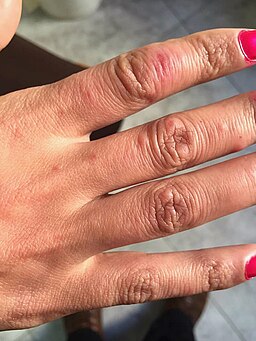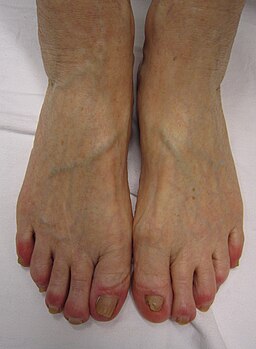Welcome to our comprehensive guide on chilblains! This article will explore the causes, symptoms, diagnosis, treatment options, prevention strategies, and tips for coping with this cold-weather condition. So, whether you are seeking information to understand chilblains better or looking for practical advice to manage and prevent them, we’ve got you covered. Chilblains can be uncomfortable, but armed with the right knowledge and proactive measures, you can minimize their impact and keep them at bay. So, let’s dive in!
Understanding Chilblains

To gain insight into chilblains, we must explore the key factors that lead to their emergence. Chilblains happens when the tiny blood vessels in your skin are harmed due to constant exposure to chilly temperatures and insufficient blood flow.
Cold weather prompts the blood vessels to tighten, restricting blood supply to your extremities and causing tissue injury. Moreover, lifestyle habits like smoking and inadequate nutrition can further hinder circulation, raising your chances of getting chilblains.
Due to their genetic makeup, some individuals may react more severely to cold temperatures, thus making them more prone to chilblains. Also, certain health conditions such as Raynaud’s disease or lupus can enhance the risk of chilblains due to compromised circulation.
Signs and Symptoms of Chilblains
Identifying the signs and symptoms of chilblains is key to getting timely help. Areas affected by chilblains usually exhibit redness, swelling, and intense itching. The skin might look patchy or speckled and feel sore when touched. Sometimes, painful blisters may also develop.
Exposure to cold tends to exacerbate chilblain symptoms, and they can worsen over time. It’s important to be mindful of possible complications like the risk of infection, ulcers, and long-term circulatory problems. If you suffer from persistent discomfort, observe any alarming changes, or if symptoms do not improve within a normal period, you should promptly consult a healthcare provider.
Diagnosing Chilblains

Diagnosing chilblains involves a review of your medical history, a physical examination, and possibly some extra tests or procedures. Your doctor will discuss your symptoms, delve into your health history, and closely inspect the areas in question.
In the physical examination, your doctor will look for typical signs of chilblains, like redness, swelling, and blisters. They might also check the temperature of your skin in the affected areas and look for any signs of infection.
Further diagnostic tests or procedures might be suggested to confirm the diagnosis or exclude other underlying conditions. These could include blood tests to check your overall health and circulation, imaging methods like Doppler ultrasound to assess blood flow, or in rare cases, a biopsy to examine the skin tissue under a microscope.
Treatment Options for Chilblains
Chilblains treatment involves a mix of self-care practices and, in some cases, medical interventions. Strategies like warming the affected areas gently and applying over-the-counter creams and ointments can offer relief for milder cases.
It’s crucial to prevent the affected areas from exposure to extreme temperatures and protect them from further damage to ease symptoms. Applying warm compresses, donning warm socks and gloves, and moisturizing can boost circulation and soothe the skin.
Your doctor might need to step in for more severe or persistent chilblains. They may prescribe topical corticosteroids to ease inflammation, vasodilators to enhance blood flow, or pain relievers to soothe discomfort. They might also suggest different therapies, like phototherapy or ultrasound, to speed up healing.
Prevention Strategies for Chilblains
Prevention plays a key role in chilblains, particularly for those who are susceptible to them. Here are some useful tips to minimize the risk:
- Dress Smartly: Embrace warm clothing with layers, hats, gloves, and thermal socks. Choose materials that offer insulation and keep moisture at bay.
- Keep Hands and Feet Cozy: Protect your extremities from the cold using hand warmers, heated insoles, or thermal socks. Dodge sudden temperature shifts.
- Boost Circulation: Engage in regular physical activities like walking, swimming, or yoga to encourage healthy blood circulation. Ditch smoking and limit alcohol, as they can hinder blood flow.
- Hydrate Your Skin: Ensure your skin stays hydrated, especially during cold, dry weather, to avert dryness and chapping. Apply a mild lotion or cream to preserve skin health.
- Limit Cold Exposure: Try to reduce extended exposure to frigid temperatures. If you must be outdoors in cold weather, take periodic indoor breaks to warm up.
By embracing these preventive measures and healthier lifestyle choices, you can drastically reduce the risk of developing and recurring chilblains.
Coping with Chilblains: Tips and Support
Managing chilblains can pose a physical and emotional challenge. Here are some strategies to help you handle the discomfort:
- Comfort Your Skin: Use soothing lotions or creams, like aloe vera or calendula, to ease the itchiness and provide temporary relief. Steer clear of scratching or rubbing the affected areas to avoid further irritation and potential skin damage.
- Divert Your Attention: Engage in enjoyable hobbies or activities that distract your focus from the discomfort. This approach can help tackle the psychological impact of chilblains.
- Manage Stress: Incorporate relaxation techniques into your daily routine, such as deep breathing exercises, meditation, or yoga, to lower stress levels. High stress can intensify symptoms and impede healing.
- Connect with Others: Join support groups or online communities where you can connect with others grappling with similar challenges. Sharing experiences and worries can provide a sense of empathy and camaraderie.
- Reach Out to Health Professionals: Discuss your concerns with healthcare providers or dermatologists specializing in vascular conditions. Their expert guidance, reassurance, and personalized advice can be invaluable in managing and preventing chilblains.
Similar Conditions to Chilblains: Similarities and Differences
While chilblains are a unique condition, it shares some common features with other disorders, especially regarding symptoms and triggers. Let’s delve into a few of these similar conditions:
Frostbite
Similarities:
- Both chilblains and frostbite result from cold temperature exposure.
- Each can cause skin discoloration, swelling, discomfort, and potential tissue harm.
- Both primarily impact extremities, such as fingers, toes, ears, and nose.
Differences:
- Frostbite is a more severe condition where tissues freeze due to long-term exposure to extreme cold.
- While chilblains usually don’t lead to tissue necrosis, frostbite can result in tissue death.
- Immediate medical attention is required for frostbite as it may lead to long-term complications, whereas chilblains often heal independently.
Raynaud’s Disease
Similarities:
- Raynaud’s disease and chilblains involve unusual blood vessel reactions to cold temperatures.
- Both can cause discomfort in the extremities and result in skin color changes.
Differences:
- Raynaud’s disease is characterized by episodes of severe blood vessel constriction (vasospasm) triggered by cold or stress.
- Chilblains occur due to prolonged cold exposure and inadequate circulation but may not involve vasospasm.
Erythromelalgia
Similarities:
- Chilblains and erythromelalgia involve blood vessel changes and affect the extremities.
- Both can cause pain, redness, and swelling in the affected areas.
Differences:
- Erythromelalgia is characterized by intense burning pain and increased temperature in the affected areas, triggered by heat or physical activity.
- Chilblains, in contrast, are triggered by cold temperatures and frequently include itching.
When dealing with these conditions, seeking a healthcare professional’s advice for an accurate diagnosis is vital, as different treatment approaches may be required.
Despite the similarities, chilblains, frostbite, Raynaud’s disease, and erythromelalgia differ in their underlying mechanisms, triggers, and symptom severity. Proper diagnosis and differentiation are crucial to ensure proper management and prevent complications. If you experience persistent or worsening symptoms, don’t hesitate to seek medical attention for an accurate diagnosis and personalized treatment plan.
Conclusion
To sum up, while chilblains can be quite bothersome, you can significantly reduce their effect and prevent their recurrence with proper knowledge and proactive habits.
Comprehending the causes, being aware of the symptoms, getting timely medical help when required, and employing prevention techniques are all key steps in protecting yourself against the discomfort brought on by chilblains.
Don’t forget the importance of staying cozy, caring for your circulation, and leading a lifestyle that puts your well-being at the forefront. With a well-informed and proactive approach, you can effectively deal with the chilly weather challenges posed by chilblains.
FAQs
Can chilblains be caught from another person?
No, chilblains are not contagious. They develop as a response to cold weather and poor circulation, not due to an infectious agent. You can’t catch chilblains from someone else or spread them to others.
Can chilblains cause permanent damage?
Usually, chilblains clear up on their own without leaving any permanent damage. However, complications such as ulcers, infections, or long-term circulation problems can develop in severe or recurring cases. You should seek medical help if you notice persistent or worsening symptoms.
Can chilblains affect other parts of the body besides the hands and feet?
Although chilblains most often appear on the hands and feet, they can occasionally appear on other body parts, including the ears, nose, or thighs. These areas can also be susceptible to cold temperatures and could develop chilblains under certain conditions.
Are there any home remedies for soothing chilblains symptoms?
Yes, several home remedies can offer relief from mild chilblains. Keeping the affected areas warm with warm compresses or soaking them in warm water can help enhance circulation and decrease discomfort. Over-the-counter creams or ointments containing menthol or camphor can temporarily relieve itching and inflammation. But remember, a healthcare professional should evaluate severe or persistent symptoms.
Can chilblains be entirely prevented?
While completely preventing chilblains may not be possible, you can certainly reduce the risk. Avoiding prolonged exposure to cold temperatures, dressing warmly, and maintaining good circulation-boosting habits like regular exercise and avoiding smoking can significantly reduce the chance of developing chilblains.
Are there particular risk factors for chilblains?
Certain factors can increase a person’s likelihood of developing chilblains. These include having a family history of chilblains, having had chilblains before, having poor circulation, living in cold and damp climates, and having certain medical conditions like Raynaud’s disease or lupus. Awareness of these risk factors can help you proactively prevent or manage chilblains.
Can chilblains be treated with medication?
While mild chilblains can typically be managed with self-care measures and home remedies, severe or recurring cases may require medication prescribed by a healthcare provider. Such medications can include topical corticosteroids, vasodilators, or pain relievers. Always consult a medical professional for an accurate diagnosis and appropriate treatment options.
Can chilblains be a symptom of an underlying medical condition?
While chilblains often result from exposure to cold temperatures and poor circulation, they can also indicate an underlying health condition. Diseases like Raynaud’s disease, lupus, diabetes, or certain autoimmune disorders can raise the risk of developing chilblains. If you frequently experience severe chilblains, consult a healthcare provider to check for underlying health issues.